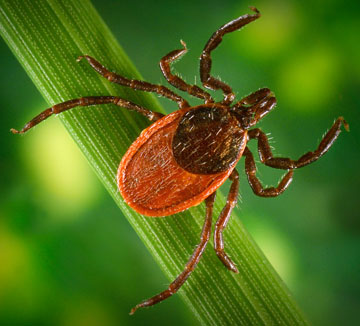DHHS → MeCDC → Disease Surveillance → Epidemiology → Vectorborne → Tick Messaging → Tick Ecology and Tick Testing

Tick Ecology and Tick Testing
Many people find ticks in Maine when enjoying the outdoors. A large part of Maine is considered a tick habitat and tick populations are increasing.
What kinds of ticks am I likely to find in Maine?
- There are 14 different tick species found in Maine.[1] The two most common species are the deer tick (Ixodes scapularis) and the American dog tick (Dermacentor variabilis).[2]
In what Maine counties am I likely to find ticks?
- Ticks are found in every county in Maine.[2],[3]
- Deer ticks (Ixodes scapularis) first inhabited the southern counties of Maine. The deer tick then spread up the coast and inland. Occasionally deer ticks are found in northern Maine.[2],[3]
- American dog ticks (Dermacentor variabilis) are most commonly found in southern Maine and their range has expanded throughout the entire state.[2]
In what habitats are deer ticks and dog ticks typically found?
- Deer ticks are usually found in wooded areas and along the forest edge. Deer ticks like areas with leaf litter and low vegetation.[4] They tend to stay low to the ground so they can find a host, since they do not jump, fly, or drop from trees.
- Dog ticks are usually found in wooded areas, in open fields with long grasses, and in brush.[5],[6]
When am I likely to find ticks?
- The Ixodes ticks have a two-year life cycle. The ticks life stages (larva, nymph, and adult) are active at different times of the year.[7]
- Adult deer ticks are most active during spring and mid to late fall. Nymph activity peaks in late June and larvae are most active in August and September. Larvae rarely attach to humans.[2]
- Although tick activity is fairly seasonal, ticks can be active at any time temperatures are above freezing. Ticks are most active above 40 degrees Farenheit.[8]
Where can I send ticks for identification and disease testing?
- The University of Maine Cooperative Extension offers a free tick identification and state of engorgement service.[9] You can mail or drop-off ticks.
- Ticks sent to UMaine Cooperative Extension help researchers chart the density and locations of tick species in the state.
- UMaine Cooperative Extension can also test ticks for the presence of Lyme disease, anaplasmosis, and babesiosis.[9] This is only available for Maine residents. The testing of tick samples is intended to provide information on ticks in Maine and is not intended to be used in human healh assessment or to be interpreted as a medical diagnosis.
- Other labs can perform testing on ticks, including:
What are the limitations to testing ticks for diseases?
- If a tick tests positive for an infection, it does not mean that the tick passed the infection to the person it fed on.
- If a tick tests negative for infection, it does not mean that the person it fed on will not get sick. The test may be wrong or there may be another tick that was not found.
- Clinical decisions should not wait until tick results are available.
References
- Maine Medical Center Research Institute Vector-borne Disease Laboratory. (n.d.). Ticks found in Maine. Retrieved from https://www.ticksinmaine.com/index.php?page=ticks
- Rand, P.W., Lacombe, E.H., Dearborn, R., Cahill, B., Elias, S., Lubelczyk, C.B., Smith, R.P. (2007). Passive surveillance in Maine, an area emergent for tick-borne diseases. Journal of Medical Entomology, 44(6), 1118-1129.
- Maine Center for Disease Control and Prevention. Maine Tracking Network. Lyme disease data. Retrieved from https://data.mainepublichealth.gov/tracking/home
- Lubelczyk, C.B., Elias, S., Rand, P.W., & Smith, R.P. (2004). Habitat associations of Ixodes scapularis in Maine. Environmental Entomology, 33(4), 900-906.
- Petry, W.K., Foré, S.A., Fielden, L.J., & Kim, H-J. (2010). A quantitative comparison of two sample methods for collecting Amblyomma americanum and Dermacentor variabilis (Acari: Ixodidae) in Missouri. Experimental and Applied Acarology, 52(4), 427-438.
- Clow, K.M., Weese, J.S., Rousseau, J., & Jardine, C.M. (2017). Microbiota of field-collected Ixodes scapularis and Dermacentor variabilis from eastern and southern Ontario, Canada. Ticks and Tick-borne Diseases. Epub ahead of print.doi: 10.1016/j.ttbdis.2017.09.009
- Yuval, B. & Spielman, A. (1990). Duration and regulation of the developmental cycle of Ixodes dammini. Journal of Medical Entomology, 27(2), 196-201. doi: 10.1093/jmedent/27.2.19
- Duffy, D.C. & Campbell, S.R. (1994). Ambient air temperature as a predictor of activity of adult Ixodes scapularis. Journal of Medical Entomology, 31(1), 178-180.
- The University of Maine Cooperative Extension. (n.d.). Cooperative Extension: Tick Lab Retrieved from https://extension.umaine.edu/ticks/submit/

